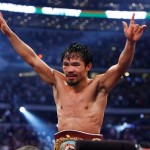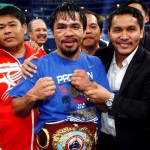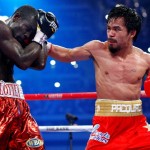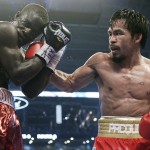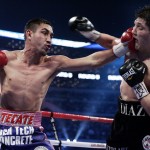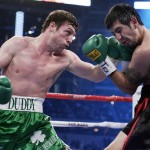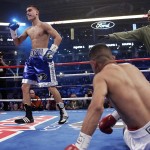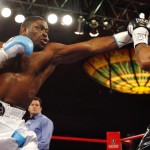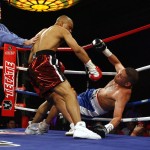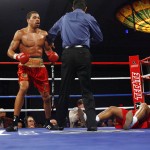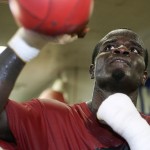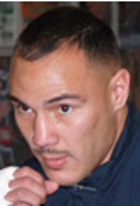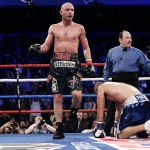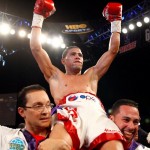Serious as can be
Keep Andre Dirrell in your prayers. What happened to him Saturday is graver than a disqualification victory. It’s about Dirrell being struck with a right uppercut on the chin and then reaching for a spot over his left eye. It’s not about a breach of sportsmanship by Arthur Abraham. It’s about Dirrell needing ice eight inches from where Abraham hit him.
It’s about Dirrell’s incoherence after the fight. It’s about his crying, “I’m hurt, man!” It’s about the way he winced and scrunched the left side of his face. It’s about an ambulance ride to the hospital for a CT scan – apparently negative, thankfully.
What a terrible way to get two points in Showtime’s Super Six World Boxing Classic.
Saturday in Detroit, American Andre Dirrell got those two points when Armenian Arthur Abraham got disqualified for an intentional foul at 1:13 of round 11. Behind by prohibitive margins on all scorecards, Abraham landed a perfect right uppercut with Dirrell on the seat of his trunks after he slipped on a Cemex Tolteca ad on the canvas.
Abraham still leads the tournament with the three points he won in October. That’s the best that can be said after his second trip to the United States from Germany, where he resides. The rest comprises the derogatory things now being thought about him in America, a country that’s still pretty important to the prizefighting world.
In some sense both men were victims of Abraham’s concussive power Saturday. Had Abraham missed with his right hand he might have stopped Dirrell in the five minutes that remained. Dirrell was fading. Had Abraham caught Dirrell with a glancing, or anyhow less-effective, punch he would have lost a point that didn’t matter anyway – à la Marco Antonio Barrera against Juan Manuel Marquez. Instead he knocked Dirrell senseless and left referee Laurence Cole no choice but to disqualify him. His record is now blemished in more than one way.
That’s nothing compared to what Abraham’s right hand may have done to Dirrell, who was on the precipice of a career-defining victory.
Gone were so many of the bad habits that had ruined Dirrell’s last fight with Carl Froch. In Saturday’s first six rounds Dirrell damn near threw a shutout against an undefeated former world champion. He threw leveraged, scientific punches, looped correctly round Abraham’s customarily high guard. He slipped punches like he wanted to counter them, not just impress his boys back home. He did almost everything the professional way.
Almost everything. There was one glaringly amateurish trait that survived Dirrell’s training camp. It happened five or six times. It was his move to the right. It was all wrong. Hands at his waist, feet crossed, chin pointed skyward, Dirrell leaped away from Abraham’s left hook. It made Abraham look ridiculous and slow. But to learned eyes, it made Dirrell look ridiculous, too.
Guess what Dirrell was doing when he slipped in the first minute of the 11th round. Dropped in the 10th from a right cross, Dirrell began the 11th wisely intending to play Keep Away. But he unwisely switched from Andre Dirrell to “The Matrix” – the kid with too much athleticism for his own good – and began to bounce back and forth, hands low. He Matrixed rightward. His right foot landed on the ‘x’ in Cemex – the sticker wet and frictionless – and his legs splayed.
That has to be the last thing Dirrell remembers from Saturday.
His hands on the canvas, Dirrell looked at Abraham’s onrushing right fist. The punch landed on the left side of his chin. Dirrell appeared disappointed, betrayed. Then the left side of his face contorted. Dirrell closed his left eye and brought his left glove to his forehead. He did not rub where he’d been struck. Rather he rubbed the place his jarred brain would have struck its protective shell. He rolled on his back. His legs began to shake involuntarily. It was ugly and frightening.
Abraham stood to the side, believing Dirrell was being theatrical – a belief he confirmed afterwards – and disbelieving he was about to lose by disqualification. What Abraham did was intentional. He deserved the result he got. But what Abraham did was not premeditated. That must be remembered.
Imagine you are Arthur Abraham. Like any man in the 31st minute of a championship prizefight, you’re more than a little buzzed from your opponent’s punches. You are desperate to sink your knuckles in the other man’s flesh. He has hit you repeatedly. He has taunted you. He has also been to the canvas minutes before. He is weakened and slowing. You have to render him unconscious or you lose.
For a half hour, he has evaded you with unorthodox moves. He drops his hands, changes levels and swoops away. You have cornered him. He struck the top of your chest with a jab after his head dropped oddly away. Now his hands are down. He is absolutely defenseless. That is a green light for you, not a red one. You throw the right hand you have cocked. You finish the defenseless man because that’s your job.
Moral judgments on Abraham need not apply here. Within the relative world of prizefighting, Abraham broke the rules and received a proper punishment. Had Dirrell been just as defenseless while standing, though – out on his feet, hands down – we’d be applauding Abraham as a great finisher for throwing that right hand.
None of this relativity helps Dirrell – a fighter about whom many things became more serious Saturday in Joe Louis Arena. If he is able to return to previous form, if subsequent tests come back negative, that is, expect the last vestiges of “The Matrix” to go away. Expect a far less playful guy in the ring. Expect a man who uses his athleticism to hurt other men. Expect some resentment at the end of those punches.
Expect that everything about Andre Dirrell just got a lot more serious.
Bart Barry can be reached via Twitter.com/bartbarry
